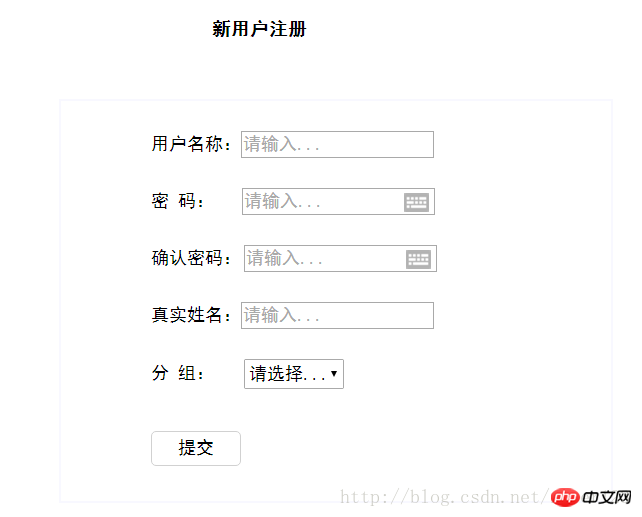Home >Web Front-end >JS Tutorial >Introduction to JavaScript form validation function
Introduction to JavaScript form validation function
- 巴扎黑Original
- 2017-08-07 16:52:172056browse
I am learning JavaScript recently, so I thought of using js to implement form verification. Through this article, I will share with you the steps to use javascript to implement the form verification function. Friends who need it can refer to it
Text box verification
The following are the verification steps for the text box.
1. Get the value of the text box to be verified,
2. Set judgment conditions on the value, using if statements or switch statements.
3. If the conditions are met, the verification passes and the return value is true.
4. If the condition is not met, the return value is false, and the text is replaced to output the verification prompt information.
5. The form obtains the return values of multiple verifications, performs logical operations, and passes the parameters to the onsubmit event of the form.
6. Call the verification function in the input. I use the onblur event to trigger the verification function.
Drop-down box verification
The verification of the drop-down box is slightly different than that of the text box. The return value of the option in the drop-down box is value , the user's choice is obtained from the name value in the select, so the value in the select is obtained through the id in the verification function of the drop-down box, and different judgments are made based on whether the value is empty or other illegal values. The rest of the steps are the same as for the text box.
The form verification style is as follows:



#Problems encountered
- There was a problem when validating the form But the form can still be submitted?
- Reason: The onsubmit event has a default parameter as a submission action. The default value of this parameter is true. As mentioned earlier, if the conditions are met, it will return true, otherwise it will return false. Each time A Boolean return value must be set in the verification of the items. If all verifications pass, the form can be submitted normally. As long as one item does not meet the conditions, the form cannot be submitted and needs to be re-entered. Therefore, each item needs to be verified. The return value of the function performs a logical operation. If all are true, the final value returned to onsubmit is true, otherwise it is false. If the parameter of onsubmit is false, it cannot be submitted, so it is implemented to prevent submission when the form verification fails.
- I entered the wrong content at the beginning, but after modifying it to the correct content, the prompt is still the same as before?
- Reason: When the return value is true, the text content of the output prompt message is set to empty, that is, document.getElementById("What").innerHTML="";
- Both onchange and onblur events can be used to trigger verification, and both will implement verification after losing focus. However, when onblur triggers verification, the user may be prompted for input due to intermittent input. The content does not meet the requirements.
- The js code snippet for form verification cannot be loaded after the page is loaded.
Code block
The following is the program source code:<script>
function validateUsername(){
var input = document.myform.userName.value;
if(input == “”||input == null) {
document.myform.userName.focus();
document.getElementById(“uname”).innerHTML=”用户名不能为空!”;
return false;
}
else if(input.length>5 || input.length<2){
document.getElementById(“uname”).innerHTML= “用户名在2~5位”;
document.myform.userName.focus();
return false;
}
else{
document.getElementById(“uname”).innerHTML=”“;
return true;
}
}
function validatePassword(){
var password = document.myform.password.value;
if(password == “”||password == null) {
document.getElementById(“upss”).innerHTML = “密码不能为空!”;
document.myform.password.focus();
return false;
}
else if(password.length>12 || password.length<6){
document.getElementById(“upss”).innerHTML= “密码在6~12位”;
document.myform.password.focus();
return false;
}
else{
document.getElementById(“upss”).innerHTML= “”;
return true;
}
}
function validatePasswordAgain(){
var psw = document.myform.psw.value;
var password = document.myform.password.value;
if(psw!=password){
document.getElementById(“upssa”).innerHTML=”两次密码输入不同”;
return false;
}else{
document.getElementById(“upssa”).innerHTML = “”;
return true;
}
}
function validateGroup(){
var select = document.getElementById(“select”);
if(select.value == “NONE”){
document.getElementById(“groupID”).innerHTML=”请选择分组!”;
return false;
}else {
document.getElementById(“groupID”).innerHTML=”“;
return true;
}
}
function validateForm(){
var flag = validateUsername()&&validatePassword()&&validatePasswordAgain()&&validateGroup();
if(flag){
return true;
}else return false;
} "html
<p class="warp">
<h1>新用户注册</h1>
<form action="/myproject/admin/addUser" name="myform" onsubmit="return validateForm()">
<p class="form-warp">
<ul>
<li>用户名称:<input class="input" type="text" name="userName" placeholder="请输入..." onblur="validateUsername()"/></li>
<li>密 码:<input class="input" type="password" name="password" id="password" placeholder="请输入..." onblur="validatePassword()"/></li>
<li>确认密码:<input class="input" type="password" name="psw" id="psw" placeholder="请输入..." onblur="validatePasswordAgain()"/></li>
<li>真实姓名:<input class="input" type="text" name="realName" placeholder="请输入..."/></li>
<li>分 组:<select name="group.id" id="select" onblur="validateGroup()">
<option value="NONE">请选择...</option>
<#list groups as group>
<option value="${group.id}">${group.name}</option>
</#list>
</select>
</li>
<li><input type="submit" value="提交" id="button"/></li>
</ul>
<ul class="validate">
<li id="uname"></li>
<li id="upss"></li>
<li id="upssa"></li>
<li id="groupID"></li>
</ul>
</p>
</form>
</p>
“`The above is the detailed content of Introduction to JavaScript form validation function. For more information, please follow other related articles on the PHP Chinese website!
Related articles
See more- An in-depth analysis of the Bootstrap list group component
- Detailed explanation of JavaScript function currying
- Complete example of JS password generation and strength detection (with demo source code download)
- Angularjs integrates WeChat UI (weui)
- How to quickly switch between Traditional Chinese and Simplified Chinese with JavaScript and the trick for websites to support switching between Simplified and Traditional Chinese_javascript skills

